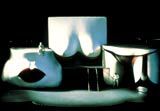Centre stage
Stage designers have to adopt a number of interesting roles in their quest for success. Nick Smurthwaite casts his eye over a new book by Tony Davis.

Designing for the stage appears to be the most glamorous job under the sun. Bucketfuls of dosh, limitless resources, endless opportunities to indulge your creative whims, eager assistants, and other creatives hanging on your every word.
But all that only applies to the successful ones, a small coterie of gifted and dedicated obsessives who get booked up for years in advance.
Tony Davis, a former theatre director and lecturer, has hand-picked a dozen designers of mixed nationality and international repute, whose work is notable for its boldness and diversity, to feature in his book Stage Design.
“Anyone looking for a tidy and coherent account of design practice will be disappointed,” he warns in his introduction. What he does offer, through interviews and his own commentary, is a lucid insight into the work of each designer, showing how they “illuminate performance with their intelligent spatial poetry,” as he puts it.
It is clear, by the end, that the successful stage designer must be part detective, part draughtsman, part technician, part dreamer and part magpie.
For Adrianne Lobel, an American specialising in opera, you could add “part actress” to the mix. While researching a modern-dress production for Marriage of Figaro, Lobel gained entry to New York’s Trump Tower disguised as an interior designer in search of an apartment for a celebrity client. “To my surprise, the estate agent showed me multi-million dollar apartments and allowed me to take pictures,” Lobel recalls.
The result was a quirky-sounding production by the director Peter Sellars that proved to be “wildly controversial”. There are many contrasting views on the designer’s role: whether it is better to make a statement, serve the text, or simply do what the director asks.
Of the make-a-statement ones, Gunther Schneider-Siemssen takes some beating. His first choice of career was conductor and, looking at his grandiose designs, you get the feeling he’s given free rein to that aspiration visually. For one opera, the composer gave no information about where the scenes were to be played, giving Schneider-Siemssen’s formidable imagination carte blanche.
George Tsypin, based in America, is not famed for his reticence. His big, bold concepts with moon-shaped stages and curved walls of wood and steel, betray his training as an architect. “I see myself as the co-author of the whole event,” he tells Davis. “Designing is an excuse for escaping into your own dream world.”
By comparison, the Brits represented seem more down-to-earth. Richard Hudson (The Lion King and Oklahoma) emphasises the importance of a good working relationship with the director.
Maria Bjornson (Phantom of the Opera) says that you have to be prepared to be flexible because your preliminary work is so often overtaken by events. With musicals she tries to avoid patronising the audience for fear of resorting to “easy viewing,” the visual equivalent of easy listening.
An essential skill for stage designers is to be able to construct intricate scale models. Bill Dudley says the model endures because it appeals to the child in everybody. “If you do a beautiful miniaturised model, people fall in love with it,” he says.
Dudley is a staunch advocate of new technology in an area of design that appears to resist it. He is the only one of this bunch who keeps a digital archive of his work. He says his “new-tech evangelism” has been met by “a kind of hostile indifference” by other designers, fearing they would lose their individuality.
The book, stylishly laid out by Lippa Pearce, contains some 530 illustrations and a useful glossary of terms commonly used by stage designers.
Stage Design by Tony Davis is published by Rotovision on 10 May, priced £24.95
-
Post a comment



